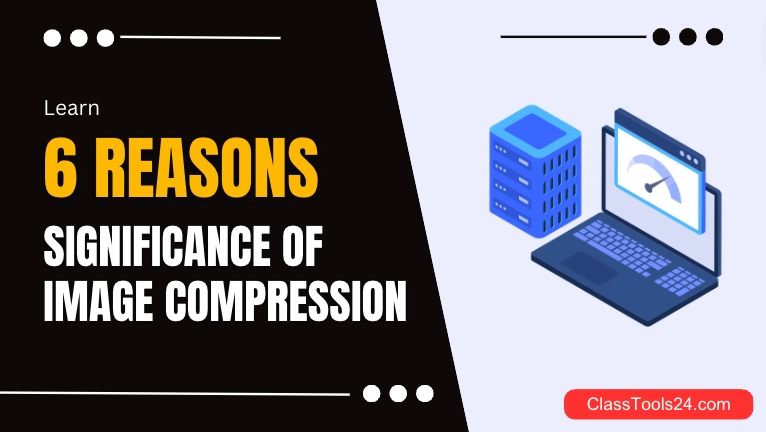What exactly image compression is?
Before jumping into the pivotal reasons behind the significance of image compression, it is essential to lay the groundwork by comprehending what this term entails. Image compression is a transformative process that plays a crucial role in optimizing digital images for various purposes.
At its core, image compression is a technique employed to reduce the file size of an image without compromising its visual quality to a significant extent. This reduction in file size is achieved through various algorithms and methodologies that eliminate redundant or unnecessary data in the image, resulting in a more compact representation. The primary goal is to strike a balance between file size reduction and maintaining an acceptable level of image quality.
To avoid further focus on explaining image compression process we move next to the significance of image compression. You can learn image compression at deep level if you are interested to learn what actually image compression is and how does it work.
Do you want to boost up your website loading speed? Just compress your website images without losing the quality.
Compress images6 Compelling Reasons for image compression
There can be many, but below are major 6 reasons that explain the importance of image compression.
- Swift Loading for User Retention: The first and foremost reason to embrace image compression is to ensure that your website loads within the optimal time frame of 2.5 seconds. Studies show that visitors are likely to abandon a website that takes too long to load. By compressing images, you reduce their file sizes, contributing to faster loading times and enhancing user retention. A compressed image will download from your website and render on a visitor's screen faster. Not only is this great for user experience, it also improves search engine optimisation (SEO).Google included its performance analysing 'Core Web Vitals' in its search algorithm. Google page speed provides a way to check your website loading speed and analyze if the images on your website are causing problems.
- Bandwidth Conservation for a Global Audience: In a world where users access websites from diverse locations and devices, conserving bandwidth becomes paramount. Compressed images require less data transfer, making your website more accessible to users with varying internet speeds. This is particularly beneficial for reaching a global audience and ensuring a positive user experience regardless of location.
- Image Compression and Enhanced User Experience: Beyond mere loading times, image compression significantly contributes to an enriched user experience. Visitors are more likely to engage with a website that delivers visuals quickly and seamlessly. Compressed images play a crucial role in creating a positive first impression and fostering a user-friendly environment.
- SEO Boost through Faster Loading: Search engine algorithms consider page loading speed as a ranking factor. Websites with faster loading times are more likely to rank higher in search results. By compressing images and improving loading speeds, you not only retain visitors but also enhance your website's search engine optimization (SEO) performance, potentially attracting more organic traffic.
- Efficient Storage Management: For website owners dealing with extensive image libraries, efficient storage management is essential. Uncompressed images can quickly eat up storage space. Image compression not only optimizes storage usage but also facilitates easier data backup and management, leading to more cost-effective and streamlined website operations.
- Compatibility Across Devices: In an era where users access websites on a variety of devices, ensuring compatibility is vital. Compressed images are more adaptable to different screen sizes and resolutions, allowing for a consistent and responsive visual experience across devices. This adaptability is crucial for retaining user interest and engagement.
FAQs:
-
Why is image compression important?
Image compression is crucial for optimizing storage space and reducing bandwidth usage. It allows images to be transmitted and stored more efficiently, which is particularly essential for websites, mobile apps, and any platform where fast loading times are crucial.
-
How does image compression impact website performance?
By compressing images, websites can significantly improve loading times, enhancing user experience. Faster-loading pages not only improve user satisfaction but also contribute to better search engine rankings, as search engines prioritize websites with faster loading speeds.
-
Does image compression affect image quality?
While image compression reduces file sizes, the extent to which it impacts image quality depends on the compression method used. Modern compression algorithms aim to strike a balance between file size reduction and maintaining acceptable image quality. Users can often choose compression levels based on their specific needs.
-
In what scenarios is image compression most beneficial?
Image compression is particularly beneficial in scenarios where large numbers of images need to be stored or transmitted, such as in e-commerce websites, social media platforms, and content delivery networks (CDNs). It helps in conserving storage space and ensuring faster content delivery.
-
Are there different types of image compression techniques?
Yes, there are various image compression techniques, broadly categorized into lossless and lossy compression. Lossless compression retains all the original image data but may not achieve as high compression ratios as lossy compression, which sacrifices some image quality for more significant file size reduction. Different formats, such as JPEG, PNG, and WebP, use different compression methods. The choice between them depends on factors like image type, use case, and desired compression level.
Your website's loading speed is a critical factor in retaining and engaging visitors. If it falls short of the 2.5-second mark, uncompressed images may be hindering its performance. Embracing image compression is not just a technical necessity; it is a strategic move to optimize user experience, enhance SEO, and manage resources efficiently. As you navigate the competitive online landscape, prioritizing image compression becomes a key element in ensuring your website remains responsive, user-friendly, and capable of capturing and retaining valuable visitors.
